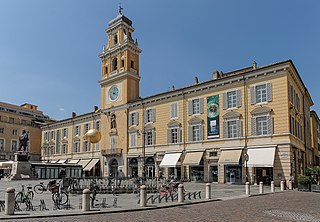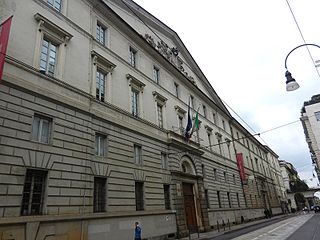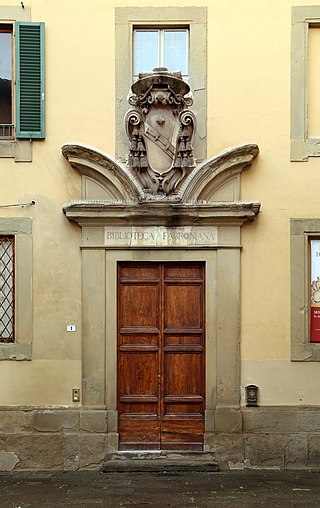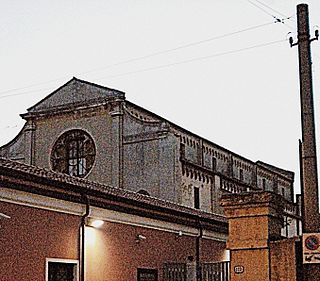Related Research Articles

Parma is a city in the northern Italian region of Emilia-Romagna known for its architecture, music, art, prosciutto (ham), cheese and surrounding countryside. With a population of 198,292 inhabitants, Parma is the second most populous city in Emilia-Romagna after Bologna, the region's capital. The city is home to the University of Parma, one of the oldest universities in the world. Parma is divided into two parts by the stream of the same name. The district on the far side of the river is Oltretorrente. Parma's Etruscan name was adapted by Romans to describe the round shield called Parma.

Pavia is a town and comune of south-western Lombardy in northern Italy, 35 kilometres south of Milan on the lower Ticino river near its confluence with the Po. It has a population of c. 73,086. The city was the capital of the Ostrogothic Kingdom from 540 to 553, of the Kingdom of the Lombards from 572 to 774, of the Kingdom of Italy from 774 to 1024 and seat of the Visconti court from 1365 to 1413.

The Mariano Moreno National Library is the largest library in Argentina. It is located in the barrio of Recoleta in Buenos Aires. The library is named after Mariano Moreno, one of the ideologists of the May Revolution and its first director.

The Marciana Library or Library of Saint Mark is a public library in Venice, Italy. It is one of the earliest surviving public libraries and repositories for manuscripts in Italy and holds one of the world's most significant collections of classical texts. It is named after St Mark, the patron saint of the city.

Francesco Barberini was an Italian Catholic Cardinal. The nephew of Pope Urban VIII, he benefited immensely from the nepotism practiced by his uncle. He was given various roles within the Vatican administration but his personal cultural interests, particularly in literature and the arts, meant that he became a highly significant patron. His secretary was the antiquarian Cassiano dal Pozzo who was also a discerning patron of the arts. Francesco was the elder brother of Cardinal Antonio Barberini and Taddeo Barberini who became Prince of Palestrina.

Verona Cathedral is a Roman Catholic cathedral in Verona, northern Italy, dedicated to the Blessed Virgin Mary under the designation Santa Maria Matricolare. It is the episcopal seat of the Diocese of Verona.

The Biblioteca nazionale centrale di Roma, in Rome, is one of two central national libraries of Italy, along with Biblioteca Nazionale Centrale di Firenze in Florence. In total, 9 national libraries exist, out of 46 state libraries.

The Biblioteca Palatina or Palatina Library was established in 1761 in the city of Parma by Philip Bourbon, Duke of Parma. It is one of the cultural institutions located in the Palazzo della Pilotta complex in the center of Parma. The Palatina Library was named after Apollus Palatinus.

The Conservatorio Statale di Musica "Gioachino Rossini" is a music conservatory in Pesaro, Italy. Founded in 1869 with a legacy from the composer Gioachino Rossini, the conservatory officially opened in 1882 with 67 students and was then known as the Liceo musicale Rossini. By 2010 it had an enrollment of approximately 850 students studying for higher diplomas in singing, instrumental performance, composition, musicology, choral conducting, jazz or electronic music. The conservatory also trains music teachers for secondary schools and holds regular master classes. Its seat is the 18th century Palazzo Olivieri–Machirelli on the Piazza Oliveri in Pesaro. Amongst its past Directors are the composers Carlo Pedrotti, Pietro Mascagni, Riccardo Zandonai and Franco Alfano. Mascagni's opera Zanetto had its world premiere at the conservatory in 1896.

The Accademia Albertina di Belle Arti is an institution of higher education in Turin, Italy

The Biblioteca Palafoxiana is a library in Puebla City's historic centre, in the Mexican state of Puebla. Founded in 1646, it is recognized by the UNESCO for being the first and oldest public library in the Americas, It has more than 45,000 books and manuscripts, ranging from the 15th to the 20th century. In 2005, it was listed on UNESCO's Memory of the World Register.

The Biblioteca Nazionale Braidense or Braidense National Library, usually known as the Biblioteca di Brera, is a public library in Milan, in northern Italy. It is one of the largest libraries in Italy. Initially it contained large historical and scientific collections before it was charged with the legal deposit of all publications from Milan. Since 1880, it has had the status of a national library and is today one of the 47 Italian State libraries.

The Scarabelli library is the public library in the city of Caltanissetta in the centre of the island of Sicily, Italy. In 1862, the library was established by Antonio Mordini in the premises of the former Jesuit convent.
San Pietro is a Roman Catholic church in central Piacenza, Emilia Romagna, Italy. The church was built over the site of an ancient church titled San Pietro in Foro.

The Biblioteca Fabroniana is a public library, founded in 1726, and located on Piazzetta San Filippo #1 in Pistoia, region of Tuscany, Italy.

The Marucelliana Library or Biblioteca Marucelliana, is a public library, founded by the mid-18th century, and located on Via Camillo Cavour # 43, in Florence, region of Tuscany, Italy.

San Giovanni di Verdara or Saint John of Verdara is a former Roman Catholic monastery and church located on Via San Giovanni di Verdara # 123, in the city of Padua, region of Veneto, Italy. It was founded in 1221, but now serves as a military hospital, and is not accessible to the public.
The following is a timeline of the history of the city of Piacenza in the Emilia-Romagna region of Italy.

San Sebastiano was a Roman Catholic church in the historic centre of Verona, Italy dedicated to Saint Sebastian. It was founded as an oratory in the 10th century, and it eventually became a parish church and was rebuilt in the Romanesque style. Between the 16th and 19th centuries, the church intermittently belonged to the Jesuits. They renovated the building in the late 16th and early 17th centuries, but the façade was only completed in 1830.
The Biblioteca Comunale Sperelliana is the main public library, since 2010 housed in the former convent of San Pietro located on Via di Fonte Avellana #8, in Gubbio, province of Perugia, Italy.